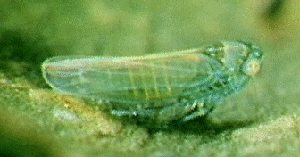Tribe Empoascini
Caution
Many of the insects depicted on these pages are outwardly similar and you should not use photographs as the sole means of identification. These pages form part of a scientific key which will assist a trained entomologist to identify the species accurately.
Tribe: Empoascini
Economic Status: A number of species of these very small leafhoppers are of economic importance in Australia and there are also exotic species which pose a biosecurity threat to Australia. Their main mode of damage is through cell rupture feeding by which cells are dissolved and the contents ingested. This causes speckling of leaves and loss of photosynthetic capacity. Some species feed on the cells surrounding the vascular bundles causing collapse of the phloem tube which leads to necrosis of distal parts of the leaves. A few species, however, feed on phloem fluid and are therefore capable of transmitting phloem-resident phytoplasma diseases.
Notes: With the exception of the Fig Leafhopper, these species are very similar in general appearance with minor differences in colouring and presence of whitish spots on the vertex and pronotum in some species and small dark spots on the tegmen in others. Identification of these species is more reliably based on examination of the male genitalia.
Click on the images below to get more information about the species.
| The Australian cotton leafhopper | |
*Amrasca biguttula biguttula (Ishida) The Indian cotton leafhopper |
 |
|
The lucerne leafhopper |
 |
Austroasca viridigrisea (Paoli) The vegetable leafhopper |
 |
Dialecticopteryx australica Kirkaldy The fig leafhopper |
 |
Distantasca smithi (Fletcher & Donaldson) The Australian citrus leafhopper |
 |
|
The cotton leafhopper |
 |
|
The birch leafhopper |
 |

